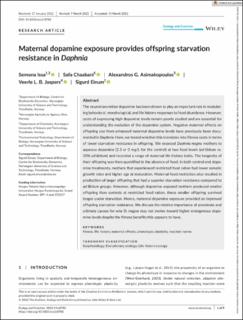| dc.contributor.author | Issa, Semona | |
| dc.contributor.author | Chaabani, Safa | |
| dc.contributor.author | Asimakopoulos, Alexandros | |
| dc.contributor.author | Jaspers, Veerle | |
| dc.contributor.author | Einum, Sigurd | |
| dc.date.accessioned | 2023-02-13T09:16:48Z | |
| dc.date.available | 2023-02-13T09:16:48Z | |
| dc.date.created | 2022-06-07T18:58:50Z | |
| dc.date.issued | 2022 | |
| dc.identifier.citation | Ecology and Evolution. 2022, 12 (4), . | en_US |
| dc.identifier.issn | 2045-7758 | |
| dc.identifier.uri | https://hdl.handle.net/11250/3050264 | |
| dc.description.abstract | The neurotransmitter dopamine has been shown to play an important role in modulating behavioral, morphological, and life history responses to food abundance. However, costs of expressing high dopamine levels remain poorly studied and are essential for understanding the evolution of the dopamine system. Negative maternal effects on offspring size from enhanced maternal dopamine levels have previously been documented in Daphnia. Here, we tested whether this translates into fitness costs in terms of lower starvation resistance in offspring. We exposed Daphnia magna mothers to aqueous dopamine (2.3 or 0 mg/L for the control) at two food levels (ad libitum vs. 30% ad libitum) and recorded a range of maternal life history traits. The longevity of their offspring was then quantified in the absence of food. In both control and dopamine treatments, mothers that experienced restricted food ration had lower somatic growth rates and higher age at maturation. Maternal food restriction also resulted in production of larger offspring that had a superior starvation resistance compared to ad libitum groups. However, although dopamine exposed mothers produced smaller offspring than controls at restricted food ration, these smaller offspring survived longer under starvation. Hence, maternal dopamine exposure provided an improved offspring starvation resistance. We discuss the relative importance of proximate and ultimate causes for why D. magna may not evolve toward higher endogenous dopamine levels despite the fitness benefits this appears to have. | en_US |
| dc.language.iso | eng | en_US |
| dc.publisher | John Wiley & Sons | en_US |
| dc.rights | Navngivelse 4.0 Internasjonal | * |
| dc.rights.uri | http://creativecommons.org/licenses/by/4.0/deed.no | * |
| dc.title | Maternal dopamine exposure provides offspring starvation resistance in Daphnia | en_US |
| dc.title.alternative | Maternal dopamine exposure provides offspring starvation resistance in Daphnia | en_US |
| dc.type | Peer reviewed | en_US |
| dc.type | Journal article | en_US |
| dc.description.version | publishedVersion | en_US |
| dc.source.volume | 12 | en_US |
| dc.source.journal | Ecology and Evolution | en_US |
| dc.source.issue | 4 | en_US |
| dc.identifier.doi | 10.1002/ece3.8785 | |
| dc.identifier.cristin | 2030051 | |
| dc.relation.project | Norges forskningsråd: 223257 | en_US |
| cristin.ispublished | true | |
| cristin.fulltext | original | |
| cristin.qualitycode | 1 | |

